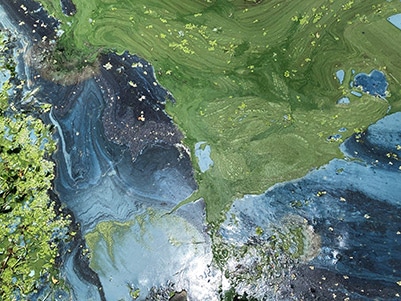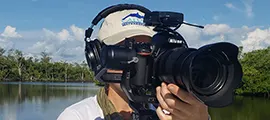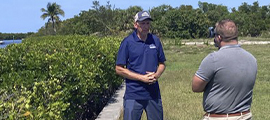Issue:
Harmful Algal Blooms

Blue-green Algae (Cyanobacteria)
Cyanobacteria is one of the oldest types of lifeforms on Earth and is found primarily in freshwater systems. There are thousands of species of cyanobacteria and many are known to produce a variety of toxins.
Cyanobacteria is a photosynthetic microorganism that processes sunlight, nitrogen and phosphorous to live. They can regualate their position in the water column for optimal light and thrive in warm, nutrient-rich fresh or brackish water with low turbulence.
Microcystis and Anabaena are two of the most common cyanobacteria found in estuarine systems today. These bacteria are known to produce cyanotoxins dangerous to humans and animals. Microcystin and Anatoxin are classes of hepatoxin and neurotoxin, affecting the liver and brain, respectively.
Human and animal exposure to Cyantoxins comes in three primary forms of contact:
- Dermal contact
- Inhalation or aspiration from aerosolized surface water
- Ingestion
Harmful algal blooms have severe impacts on human health, aquatic ecosystems and our economy.
Red Tide (Karenia brevis)
Red tide is a marine dinoflagellate found in saltwater, and has been known to inhabit the Gulf of Mexico throughout recorded history. Red tide blooms have been increasing in scope and intensity within the last 30 years. Red tide has also occurred throughout the Gulf and Atlantic Coast, reaching as far as North Carolina.
Karenia brevis can utilize at least 12 different forms of nutrients and also consume other single cell organisms for food. They are capable of motion and directed swimming allowing them greater access to nutrients.
Red Tide produces brevatoxins which can be deadly to many sea animals and often causes acute respiratory symptoms in humans. Aerosolized health effects include irritation of the eyes, nose, throat and lungs and exacerbating occurrences of respiratory distress, bronchitis, asthma and pneumonia. Brevatoxin can also have a serious impact on the marine food-chain, contributing to shellfish poisoning and gastrointestinal disorders.

Take Action
Contact Your State Legislators
Calusa Waterkeeper calls on citizens and stakeholders to urge elected officials and responsible agencies to take the following ten actions:
The toxic blue-green algae (cyanobacteria) often stretching from Lake Okeechobee to our west coast is the result of decades of failed water policy implementation. A perfect storm of lax enforcement and under-funding at the local, state and national levels has culminated in the historic harmful algae blooms (HABs) that plagued our region in 2018 (and so many other years).
If political leaders fail to take action, history is doomed to repeat itself year after year, causing catastrophic harm to our ecosystem and our economy.
The science is clear on what needs to be done.
What has been lacking is the political will to enact the regulation and legislation required to begin to reverse these problems. We look to you, as informed citizens, to proactively communicate your water quality concerns to newly elected officials. It will take a groundswell of voices if we are to affect change in Tallahassee during this coming legislative session.
Find Your Legislators
Related News Stories
Harmful Algal Blooms
Florida Officials Urged to Set Standards to Protect People, Wildlife From Harmful Algae Blooms
Calusa Waterkeeper, The Center for Biological Diversity and Sanibel-Captiva Conservation Foundation are calling on the Florida Department of Environmental Protection to establish legal limits for cyanotoxins that pose severe health risks to people and wildlife.
Dead Sea Life, Red Drift Algae Piled up on Fort Myers Beach
Beachgoers felt the effects of water quality issues along some SWFL beaches. John Cassani, ecologist and founder of Calusa Waterkeeper, says red tide continues to cause fish kills along Fort Myers Beach, while the beach is also lined with piles of what appears to be red drift algae.
Battle Over Water and Public Health Returns to Florida Lawmakers
After the last prolonged outbreak of red tide and blue-green algae, it seemed every politician vowed to “do something.” The spin from the last session was that the Florida Legislature produced “the most Everglades-friendly budget in Florida history.”
Waterkeepers Florida Recommends State Standards for Cyanotoxins
Waterkeepers Florida submitted comments to the Florida Department of Environmental Protection, as part of their triennial review process. In the letter, we lay out the history and importance of Florida accepting and codifying a numerical standard for cyanotoxins.
Florida Petitioned to Protect People From Harmful Algae Blooms
The Center for Biological Diversity, Sanibel-Captiva Conservation Foundation and Calusa Waterkeeper petitioned the Florida Department of Environmental Protection to protect the public from toxins in the harmful algal blooms that keep reoccurring in the state.
How Much Algae Toxin is too Much? Environmental Groups Urge EPA to Adopt Stricter Guidelines for Recreational Exposure
Amid rising concern about the potential health effects of toxic algae, the EPA released official safety advice that advocates say falls far short of protecting the public. Three environmental nonprofits are petitioning the FDEP to adopt the EPA’s 2016 recommendations instead.
Make a Donation
Get Notified
Priority Issues
Harmful Algal Blooms
Cyanobacteria & Red Tide
Cyanobacteria (blue-green algae) and Karenia brevis (red tide) have been making major impacts on Southwest Florida.
Lake Okeechobee Discharges
Revise System Operating Manual
The Caloosahatchee River often suffers from too much freshwater in the wet season, and not enough freshwater in the dry season.
Cape Coral Spreader Canals
Nutrient & Sediment Loading
The City of Cape Coral is working to remove large storm-water barriers to make recreational boating more convenient.
Bacteria Monitoring
Fecal Indicator Bacteria
Calusa Waterkeeper has been at the forefront of monitoring this Fort Myers tributary for fecal bacteria indicators.




































